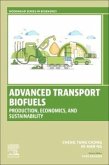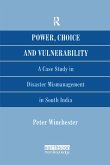Advanced Hydroinformatics in Vulnerability Assessments and Mitigative Interventions
Volume 20
Herausgeber: Majumder, Mrinmoy; Kale, Ganesh D; Srivastava, Rajiv Kumar; Singh, V P
Versandkostenfrei innerhalb Deutschlands
128,99 €
inkl. MwSt.
Versandkostenfrei*
Erscheint vorauss. 1. Mai 2026
Melden Sie sich
hier
hier
für den Produktalarm an, um über die Verfügbarkeit des Produkts informiert zu werden.

64 °P sammeln
Advanced Hydroinformatics in Vulnerability Assessments and Mitigative Interventions
Volume 20
Herausgeber: Majumder, Mrinmoy; Kale, Ganesh D; Srivastava, Rajiv Kumar; Singh, V P
- Broschiertes Buch
Advanced Hydroinformatics in Vulnerability Assessments and Mitigative Interventions is a comprehensive guide that explores the role of hydroinformatics in managing peri-urban watersheds amidst challenges such as climate change and urbanization. Leveraging artificial intelligence, data science, and Internet of Things, this book presents innovative strategies for optimal management of natural resources. The book uniquely combines theory and case studies to illustrate the application of data science, AI, and other technologies in assessing vulnerabilities and developing mitigation strategies for…mehr
Andere Kunden interessierten sich auch für
![Advanced Transport Biofuels Advanced Transport Biofuels]() Cheng Tung ChongAdvanced Transport Biofuels264,99 €
Cheng Tung ChongAdvanced Transport Biofuels264,99 €![Power, Choice and Vulnerability Power, Choice and Vulnerability]() Peter WinchesterPower, Choice and Vulnerability32,99 €
Peter WinchesterPower, Choice and Vulnerability32,99 €![Engineering Vulnerability Engineering Vulnerability]() Sarah E VaughnEngineering Vulnerability27,99 €
Sarah E VaughnEngineering Vulnerability27,99 €![Advanced Computational Techniques for Sustainable Computing Advanced Computational Techniques for Sustainable Computing]() Advanced Computational Techniques for Sustainable Computing67,99 €
Advanced Computational Techniques for Sustainable Computing67,99 €![Advanced Oxidation Handbook, First Edition Advanced Oxidation Handbook, First Edition]() James R Bolton James CollinsAdvanced Oxidation Handbook, First Edition134,99 €
James R Bolton James CollinsAdvanced Oxidation Handbook, First Edition134,99 €![Management of Mycorrhizal Symbiosis for Mycoremediation and Phytostabilization Management of Mycorrhizal Symbiosis for Mycoremediation and Phytostabilization]() Management of Mycorrhizal Symbiosis for Mycoremediation and Phytostabilization134,99 €
Management of Mycorrhizal Symbiosis for Mycoremediation and Phytostabilization134,99 €![Microplastics Microplastics]() Microplastics134,99 €
Microplastics134,99 €-
-
-
Advanced Hydroinformatics in Vulnerability Assessments and Mitigative Interventions is a comprehensive guide that explores the role of hydroinformatics in managing peri-urban watersheds amidst challenges such as climate change and urbanization. Leveraging artificial intelligence, data science, and Internet of Things, this book presents innovative strategies for optimal management of natural resources. The book uniquely combines theory and case studies to illustrate the application of data science, AI, and other technologies in assessing vulnerabilities and developing mitigation strategies for peri-urban watersheds. Readers will find Advanced Hydroinformatics in Vulnerability Assessments and Mitigative Interventions an invaluable resource for understanding and applying hydroinformatics to address their water-related challenges.
Produktdetails
- Produktdetails
- Verlag: Elsevier Science
- Seitenzahl: 350
- Erscheinungstermin: 1. Mai 2026
- Englisch
- ISBN-13: 9780443364280
- ISBN-10: 0443364281
- Artikelnr.: 74313114
- Herstellerkennzeichnung
- Libri GmbH
- Europaallee 1
- 36244 Bad Hersfeld
- gpsr@libri.de
- Verlag: Elsevier Science
- Seitenzahl: 350
- Erscheinungstermin: 1. Mai 2026
- Englisch
- ISBN-13: 9780443364280
- ISBN-10: 0443364281
- Artikelnr.: 74313114
- Herstellerkennzeichnung
- Libri GmbH
- Europaallee 1
- 36244 Bad Hersfeld
- gpsr@libri.de
Section I: Application of Hydro informatics in Integrated Watershed
Management
1. Impact of Manholes in Flood Simulation of Micro Catchments: An AHP -
GMDH Approach.
2. Agricultural Runoff and Water Quality: Hydroinformatics in Action.
3. Minimization of virtual water of a Peri-Urban capital city in face of
climate change: case study of Tea Industry.
4. Application of Modified Version of First Innovative Approach for
Prioritization of Blocks in The Barmer District.
5. Location Selection for Rain-Water Harvesting Plants with the help of
GWA-Based Neural Networks.
6. Prioritisation of Blocks in Udaipur Division with Investigation of
Factors Affecting Declining Groundwater.
7. Application of Two Innovative Approaches to Know Where and Why
Groundwater Management Strategies are Necessary at The Jodhpur Division.
8. Development of Desertification Potential Model for peri-urban Watershed
Considering Climatic Vulnerability.
9. Impact of Brick Industry on Surface Water Vulnerability Analysis: A
PROMETHEE-ELECTRE Approach.
10. Vulnerability Analysis of Peri-Urban Watershed with Respect to Climate
Change and Urbanization.
11. Development of a Groundwater Vulnerability Index with the Help of MCDM
and GIS.
12. Impact of Climate Change on Pollution Content of Peri-Urban River- A
Polynomial Neural Network Approach.
Section II: Application of Hydroinformatics in Water and Energy Nexus
13. Development of a Spatial Predictive Model for Estimation of Flow Rate
in Penstock Networks.
14. Wave Powered Desalination for Delivering Clean Water to Developing
Countries and Island Nations.
15. Application of Nature-Based Optimization Techniques in Optimizing Water
Used in Renewable Energy.
16. Minimization of Energy Use in Surface Water Treatment Plant.
17. Optimization of the Performance Management System of Wave Energy
Converters with The Help of Multi-Criteria Decision Techniques and
Bio-Inspired Algorithms.
18. Development of Indicator-Based Real-time Pen Stock Condition Monitoring
System by the Application of GIS and Cognitive Tools.
19. Selection of A Suitable Location for The Installation of a Wave Energy
Converter in The Indian Coastal Zone: An MCDM and Reliability Analysis
Approach.
20. Design and Development of Low-Cost Solar Based Domestic Water Filter.
Section III: Application of Hydro informatics in Coastal Vulnerability
Assessment
21. Impact of Saline Water Intrusion on Water Conservation of a Coastal
Zone in Equatorial India.
22. Predictive Hydroinformatics: Reducing Flood Risks through Advanced
Modeling.
23. Flood Mitigation in Farmlands: Modeling and Simulation Techniques
24. Satellite Remote Sensing for Flood Prediction and Management: A Case
Study
25. Application of Artificial Intelligence in Impact Analysis of Saline
Water Intrusion on Coastal Wetlands.
26. Impact of Tsunami on Island Coasts: The Most Effected Parameter
Approach.
27. Impact of Paper Industry on Coastal Zone Vulnerabilities: An AHP - GMDH
Approach.
28. Impact of Climate Change on Tropical Coasts: A OPAAHP Approach.
29. Optimal Resource Allocation within Peri-Urban Consumers of a Coastal
Zone with The Help of Mine Burst and Glowworm Optimization Technique.
30. Vulnerability Analysis of Tropical Coastal Zone Under Changed Climate
Scenarios with The Help of Water Cycle and Dolphin Algorithm.
31. Vulnerability Analysis of a Shallow Coastal Zone with Respect to
Volcanic Storms: A MERC - GWA Approach. Section IV: Application of Hydro
informatics in Vulnerability Assessment of Wetlands
32. Monitoring Grey Water Recycle Potential of a Wetland: A Group Method of
Data Handling Approach.
33. Data-Driven Strategies for Reducing Agricultural Water Footprint
34. WETMAN: An App to Manage Wetland Resources.
35. Innovative Water Management: Hydroinformatics Solutions to Prevent
Droughts in Agriculture.
36. Vulnerability Analysis of Wetlands under Changed Climate Scenarios with
The Help of Water Cycle and Poly-Neural Networks.
37. Application of Particle Swarm and Cat Swarm Algorithm in Vulnerability
Assessment of Blue Water Management with Respect to Wetlands.
38. Risk Minimization of Wetlands from Climatic Vulnerabilities by Firefly
and Glowworm Optimization Techniques.
39. Wetland Reliability Analysis by Dynamic Soaring of Albatross Algorithm
with respect to a Peri-Urban Stakeholders.
Management
1. Impact of Manholes in Flood Simulation of Micro Catchments: An AHP -
GMDH Approach.
2. Agricultural Runoff and Water Quality: Hydroinformatics in Action.
3. Minimization of virtual water of a Peri-Urban capital city in face of
climate change: case study of Tea Industry.
4. Application of Modified Version of First Innovative Approach for
Prioritization of Blocks in The Barmer District.
5. Location Selection for Rain-Water Harvesting Plants with the help of
GWA-Based Neural Networks.
6. Prioritisation of Blocks in Udaipur Division with Investigation of
Factors Affecting Declining Groundwater.
7. Application of Two Innovative Approaches to Know Where and Why
Groundwater Management Strategies are Necessary at The Jodhpur Division.
8. Development of Desertification Potential Model for peri-urban Watershed
Considering Climatic Vulnerability.
9. Impact of Brick Industry on Surface Water Vulnerability Analysis: A
PROMETHEE-ELECTRE Approach.
10. Vulnerability Analysis of Peri-Urban Watershed with Respect to Climate
Change and Urbanization.
11. Development of a Groundwater Vulnerability Index with the Help of MCDM
and GIS.
12. Impact of Climate Change on Pollution Content of Peri-Urban River- A
Polynomial Neural Network Approach.
Section II: Application of Hydroinformatics in Water and Energy Nexus
13. Development of a Spatial Predictive Model for Estimation of Flow Rate
in Penstock Networks.
14. Wave Powered Desalination for Delivering Clean Water to Developing
Countries and Island Nations.
15. Application of Nature-Based Optimization Techniques in Optimizing Water
Used in Renewable Energy.
16. Minimization of Energy Use in Surface Water Treatment Plant.
17. Optimization of the Performance Management System of Wave Energy
Converters with The Help of Multi-Criteria Decision Techniques and
Bio-Inspired Algorithms.
18. Development of Indicator-Based Real-time Pen Stock Condition Monitoring
System by the Application of GIS and Cognitive Tools.
19. Selection of A Suitable Location for The Installation of a Wave Energy
Converter in The Indian Coastal Zone: An MCDM and Reliability Analysis
Approach.
20. Design and Development of Low-Cost Solar Based Domestic Water Filter.
Section III: Application of Hydro informatics in Coastal Vulnerability
Assessment
21. Impact of Saline Water Intrusion on Water Conservation of a Coastal
Zone in Equatorial India.
22. Predictive Hydroinformatics: Reducing Flood Risks through Advanced
Modeling.
23. Flood Mitigation in Farmlands: Modeling and Simulation Techniques
24. Satellite Remote Sensing for Flood Prediction and Management: A Case
Study
25. Application of Artificial Intelligence in Impact Analysis of Saline
Water Intrusion on Coastal Wetlands.
26. Impact of Tsunami on Island Coasts: The Most Effected Parameter
Approach.
27. Impact of Paper Industry on Coastal Zone Vulnerabilities: An AHP - GMDH
Approach.
28. Impact of Climate Change on Tropical Coasts: A OPAAHP Approach.
29. Optimal Resource Allocation within Peri-Urban Consumers of a Coastal
Zone with The Help of Mine Burst and Glowworm Optimization Technique.
30. Vulnerability Analysis of Tropical Coastal Zone Under Changed Climate
Scenarios with The Help of Water Cycle and Dolphin Algorithm.
31. Vulnerability Analysis of a Shallow Coastal Zone with Respect to
Volcanic Storms: A MERC - GWA Approach. Section IV: Application of Hydro
informatics in Vulnerability Assessment of Wetlands
32. Monitoring Grey Water Recycle Potential of a Wetland: A Group Method of
Data Handling Approach.
33. Data-Driven Strategies for Reducing Agricultural Water Footprint
34. WETMAN: An App to Manage Wetland Resources.
35. Innovative Water Management: Hydroinformatics Solutions to Prevent
Droughts in Agriculture.
36. Vulnerability Analysis of Wetlands under Changed Climate Scenarios with
The Help of Water Cycle and Poly-Neural Networks.
37. Application of Particle Swarm and Cat Swarm Algorithm in Vulnerability
Assessment of Blue Water Management with Respect to Wetlands.
38. Risk Minimization of Wetlands from Climatic Vulnerabilities by Firefly
and Glowworm Optimization Techniques.
39. Wetland Reliability Analysis by Dynamic Soaring of Albatross Algorithm
with respect to a Peri-Urban Stakeholders.
Section I: Application of Hydro informatics in Integrated Watershed
Management
1. Impact of Manholes in Flood Simulation of Micro Catchments: An AHP -
GMDH Approach.
2. Agricultural Runoff and Water Quality: Hydroinformatics in Action.
3. Minimization of virtual water of a Peri-Urban capital city in face of
climate change: case study of Tea Industry.
4. Application of Modified Version of First Innovative Approach for
Prioritization of Blocks in The Barmer District.
5. Location Selection for Rain-Water Harvesting Plants with the help of
GWA-Based Neural Networks.
6. Prioritisation of Blocks in Udaipur Division with Investigation of
Factors Affecting Declining Groundwater.
7. Application of Two Innovative Approaches to Know Where and Why
Groundwater Management Strategies are Necessary at The Jodhpur Division.
8. Development of Desertification Potential Model for peri-urban Watershed
Considering Climatic Vulnerability.
9. Impact of Brick Industry on Surface Water Vulnerability Analysis: A
PROMETHEE-ELECTRE Approach.
10. Vulnerability Analysis of Peri-Urban Watershed with Respect to Climate
Change and Urbanization.
11. Development of a Groundwater Vulnerability Index with the Help of MCDM
and GIS.
12. Impact of Climate Change on Pollution Content of Peri-Urban River- A
Polynomial Neural Network Approach.
Section II: Application of Hydroinformatics in Water and Energy Nexus
13. Development of a Spatial Predictive Model for Estimation of Flow Rate
in Penstock Networks.
14. Wave Powered Desalination for Delivering Clean Water to Developing
Countries and Island Nations.
15. Application of Nature-Based Optimization Techniques in Optimizing Water
Used in Renewable Energy.
16. Minimization of Energy Use in Surface Water Treatment Plant.
17. Optimization of the Performance Management System of Wave Energy
Converters with The Help of Multi-Criteria Decision Techniques and
Bio-Inspired Algorithms.
18. Development of Indicator-Based Real-time Pen Stock Condition Monitoring
System by the Application of GIS and Cognitive Tools.
19. Selection of A Suitable Location for The Installation of a Wave Energy
Converter in The Indian Coastal Zone: An MCDM and Reliability Analysis
Approach.
20. Design and Development of Low-Cost Solar Based Domestic Water Filter.
Section III: Application of Hydro informatics in Coastal Vulnerability
Assessment
21. Impact of Saline Water Intrusion on Water Conservation of a Coastal
Zone in Equatorial India.
22. Predictive Hydroinformatics: Reducing Flood Risks through Advanced
Modeling.
23. Flood Mitigation in Farmlands: Modeling and Simulation Techniques
24. Satellite Remote Sensing for Flood Prediction and Management: A Case
Study
25. Application of Artificial Intelligence in Impact Analysis of Saline
Water Intrusion on Coastal Wetlands.
26. Impact of Tsunami on Island Coasts: The Most Effected Parameter
Approach.
27. Impact of Paper Industry on Coastal Zone Vulnerabilities: An AHP - GMDH
Approach.
28. Impact of Climate Change on Tropical Coasts: A OPAAHP Approach.
29. Optimal Resource Allocation within Peri-Urban Consumers of a Coastal
Zone with The Help of Mine Burst and Glowworm Optimization Technique.
30. Vulnerability Analysis of Tropical Coastal Zone Under Changed Climate
Scenarios with The Help of Water Cycle and Dolphin Algorithm.
31. Vulnerability Analysis of a Shallow Coastal Zone with Respect to
Volcanic Storms: A MERC - GWA Approach. Section IV: Application of Hydro
informatics in Vulnerability Assessment of Wetlands
32. Monitoring Grey Water Recycle Potential of a Wetland: A Group Method of
Data Handling Approach.
33. Data-Driven Strategies for Reducing Agricultural Water Footprint
34. WETMAN: An App to Manage Wetland Resources.
35. Innovative Water Management: Hydroinformatics Solutions to Prevent
Droughts in Agriculture.
36. Vulnerability Analysis of Wetlands under Changed Climate Scenarios with
The Help of Water Cycle and Poly-Neural Networks.
37. Application of Particle Swarm and Cat Swarm Algorithm in Vulnerability
Assessment of Blue Water Management with Respect to Wetlands.
38. Risk Minimization of Wetlands from Climatic Vulnerabilities by Firefly
and Glowworm Optimization Techniques.
39. Wetland Reliability Analysis by Dynamic Soaring of Albatross Algorithm
with respect to a Peri-Urban Stakeholders.
Management
1. Impact of Manholes in Flood Simulation of Micro Catchments: An AHP -
GMDH Approach.
2. Agricultural Runoff and Water Quality: Hydroinformatics in Action.
3. Minimization of virtual water of a Peri-Urban capital city in face of
climate change: case study of Tea Industry.
4. Application of Modified Version of First Innovative Approach for
Prioritization of Blocks in The Barmer District.
5. Location Selection for Rain-Water Harvesting Plants with the help of
GWA-Based Neural Networks.
6. Prioritisation of Blocks in Udaipur Division with Investigation of
Factors Affecting Declining Groundwater.
7. Application of Two Innovative Approaches to Know Where and Why
Groundwater Management Strategies are Necessary at The Jodhpur Division.
8. Development of Desertification Potential Model for peri-urban Watershed
Considering Climatic Vulnerability.
9. Impact of Brick Industry on Surface Water Vulnerability Analysis: A
PROMETHEE-ELECTRE Approach.
10. Vulnerability Analysis of Peri-Urban Watershed with Respect to Climate
Change and Urbanization.
11. Development of a Groundwater Vulnerability Index with the Help of MCDM
and GIS.
12. Impact of Climate Change on Pollution Content of Peri-Urban River- A
Polynomial Neural Network Approach.
Section II: Application of Hydroinformatics in Water and Energy Nexus
13. Development of a Spatial Predictive Model for Estimation of Flow Rate
in Penstock Networks.
14. Wave Powered Desalination for Delivering Clean Water to Developing
Countries and Island Nations.
15. Application of Nature-Based Optimization Techniques in Optimizing Water
Used in Renewable Energy.
16. Minimization of Energy Use in Surface Water Treatment Plant.
17. Optimization of the Performance Management System of Wave Energy
Converters with The Help of Multi-Criteria Decision Techniques and
Bio-Inspired Algorithms.
18. Development of Indicator-Based Real-time Pen Stock Condition Monitoring
System by the Application of GIS and Cognitive Tools.
19. Selection of A Suitable Location for The Installation of a Wave Energy
Converter in The Indian Coastal Zone: An MCDM and Reliability Analysis
Approach.
20. Design and Development of Low-Cost Solar Based Domestic Water Filter.
Section III: Application of Hydro informatics in Coastal Vulnerability
Assessment
21. Impact of Saline Water Intrusion on Water Conservation of a Coastal
Zone in Equatorial India.
22. Predictive Hydroinformatics: Reducing Flood Risks through Advanced
Modeling.
23. Flood Mitigation in Farmlands: Modeling and Simulation Techniques
24. Satellite Remote Sensing for Flood Prediction and Management: A Case
Study
25. Application of Artificial Intelligence in Impact Analysis of Saline
Water Intrusion on Coastal Wetlands.
26. Impact of Tsunami on Island Coasts: The Most Effected Parameter
Approach.
27. Impact of Paper Industry on Coastal Zone Vulnerabilities: An AHP - GMDH
Approach.
28. Impact of Climate Change on Tropical Coasts: A OPAAHP Approach.
29. Optimal Resource Allocation within Peri-Urban Consumers of a Coastal
Zone with The Help of Mine Burst and Glowworm Optimization Technique.
30. Vulnerability Analysis of Tropical Coastal Zone Under Changed Climate
Scenarios with The Help of Water Cycle and Dolphin Algorithm.
31. Vulnerability Analysis of a Shallow Coastal Zone with Respect to
Volcanic Storms: A MERC - GWA Approach. Section IV: Application of Hydro
informatics in Vulnerability Assessment of Wetlands
32. Monitoring Grey Water Recycle Potential of a Wetland: A Group Method of
Data Handling Approach.
33. Data-Driven Strategies for Reducing Agricultural Water Footprint
34. WETMAN: An App to Manage Wetland Resources.
35. Innovative Water Management: Hydroinformatics Solutions to Prevent
Droughts in Agriculture.
36. Vulnerability Analysis of Wetlands under Changed Climate Scenarios with
The Help of Water Cycle and Poly-Neural Networks.
37. Application of Particle Swarm and Cat Swarm Algorithm in Vulnerability
Assessment of Blue Water Management with Respect to Wetlands.
38. Risk Minimization of Wetlands from Climatic Vulnerabilities by Firefly
and Glowworm Optimization Techniques.
39. Wetland Reliability Analysis by Dynamic Soaring of Albatross Algorithm
with respect to a Peri-Urban Stakeholders.







